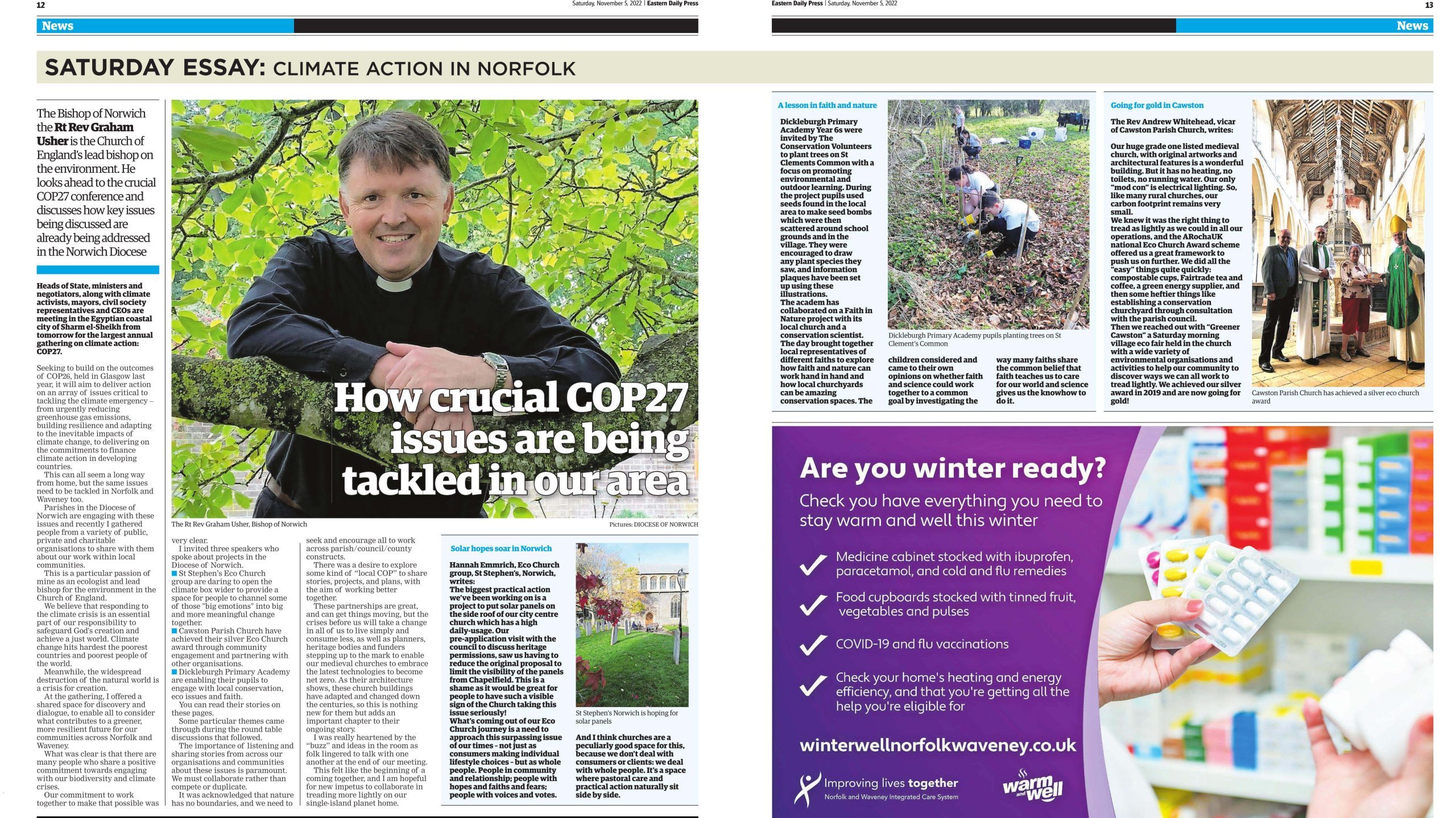Heads of State, ministers and negotiators, along with climate activists, mayors, civil society representatives and CEOs are currently meeting in the Egyptian coastal city of Sharm el-Sheikh for the largest annual gathering on climate action: COP27.
Seeking to build on the outcomes of COP26, held in Glasgow last year, it will aim to deliver action on an array of issues critical to tackling the climate emergency – from urgently reducing greenhouse gas emissions, building resilience and adapting to the inevitable impacts of climate change, to delivering on the commitments to finance climate action in developing countries. This can all seem a long way from home, but the same issues need to be tackled in Norfolk and Waveney too.
Parishes in the Diocese of Norwich are engaging with these issues and recently I gathered people from a variety of public, private and charitable organisations to share with them about our work within local communities. This is a particular passion of mine as an ecologist and lead bishop for the environment in the Church of England.
We believe that responding to the climate crisis is an essential part of our responsibility to safeguard God’s creation and achieve a just world. Climate change hits hardest the poorest countries and poorest people of the world. Meantime, the widespread destruction of the natural world is a crisis for creation.
At the gathering, I offered a shared space for discovery and dialogue, to enable all to consider what contributes to a greener, more resilient future for our communities across Norfolk and Waveney.
What was clear is that there are many people who share a positive commitment towards engaging with our biodiversity and climate crises. Our commitment to work together to make that possible was very clear.
I invited three speakers who spoke about projects in the Diocese of Norwich. St Stephen’s Eco Church group are daring to open the climate box wider to provide a space for people to channel some of those ‘big emotions’ into big and more meaningful change together. Cawston Parish Church achieving their silver Eco Church award through community engagement and partnering with other organisations. Dickleburgh Primary Academy enabling their pupils to engage with local conservation, eco issues and faith. You can read their stories below.
Some particular themes came through during the roundtable discussions that followed.
The importance of listening and sharing stories from across our organisations and communities about these issues is paramount. We must collaborate rather than compete or duplicate.
It was acknowledged that nature has no boundaries, and we need to seek and encourage all to work across parish/council/county constructs.
There was a desire to explore some kind of “local COP” to share stories, projects, and plans, with the aim of working better together.
These partnerships are great, and can get things moving, but the crises before us will take a change in all of us to live simply and consume less, as well as planners, heritage bodies and funders stepping up to the mark to enable our medieval churches to embrace the latest technologies to become net zero. As their architecture shows, these church buildings have adapted and changed down the centuries, so this is nothing new for them but adds an important chapter to their ongoing story.
I was really heartened by the “buzz” and ideas in the room as folk lingered to talk with one another at the end of our meeting. This felt like the beginning of a coming together, and I am hopeful for new impetus to collaborate in treading more lightly on our single-island planet home.
Going for gold in Cawston
 The Revd Andrew Whitehead, Vicar of Cawston Parish Church writes:
The Revd Andrew Whitehead, Vicar of Cawston Parish Church writes:
Our huge grade one listed medieval church, with original artworks and architectural features is a wonderful building. But it has no heating, no toilets, no running water. Our only “mod con” is electrical lighting. So, like many rural churches, our carbon footprint remains very small.
We knew it was the right thing to tread as lightly as we could in all our operations, and the ARochaUK national Eco Church Award scheme offered us a great framework to push us on further. We did all the “easy” things quite quickly: compostable cups, Fairtrade tea and coffee, a green energy supplier, and then some heftier things like establishing a conservation churchyard through consultation with the parish council.
Then we reached out with “Greener Cawston” a Saturday morning village eco fair held in the church with a wide variety of environmental organisations and activities to help our community to discover ways we can all work to tread lightly. We achieved our silver award in 2019 and are now going for gold!
Solar hopes soar in Norwich
 Hannah Emmrich, Eco Church group, St Stephen’s, Norwich writes:
Hannah Emmrich, Eco Church group, St Stephen’s, Norwich writes:
The biggest practical action we’ve been working on is a project to put solar panels on the side roof of our city centre church which has a high daily-usage. Our pre-application visit with the council to discuss heritage permissions, saw us having to reduce the original proposal to limit the visibility of the panels from Chapelfield. This is a shame as it would be great for people to have such a visible sign of the Church taking this issue seriously!
What’s coming out of our Eco Church journey is a need to approach this surpassing issue of our times – not just as consumers making individual lifestyle choices – but as whole people. People in community and relationship; people with hopes and faiths and fears; people with voices and votes. And I think churches are a peculiarly good space for this, because we don’t deal with consumers or clients: we deal with whole people. It’s a space where pastoral care and practical action naturally sit side by side.
A lesson in faith and nature
 Dickleburgh CofE Primary Academy Year 6s were invited by The Conservation Volunteers to plant trees on St Clements Common with a focus on promoting environmental and outdoor learning. During the project pupils used seeds found in the local area to make seed bombs which were then scattered around school grounds and in the village. They were encouraged to draw any plant species they saw, and information plaques have been set up using these illustrations.
Dickleburgh CofE Primary Academy Year 6s were invited by The Conservation Volunteers to plant trees on St Clements Common with a focus on promoting environmental and outdoor learning. During the project pupils used seeds found in the local area to make seed bombs which were then scattered around school grounds and in the village. They were encouraged to draw any plant species they saw, and information plaques have been set up using these illustrations.
The Academy also collaborated on a Faith in Nature project with their local church and a conservation scientist. The day brought together local representatives of different faiths to explore how faith and nature can work hand in hand and how local churchyards can be amazing conservation spaces. The children considered and came to their own opinions on whether faith and science could work together to a common goal by investigating the way many faiths share the common belief that faith teaches us to care for our world and science gives us the knowhow to do it.
This article first appeared in the EDP here


